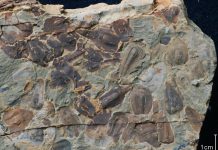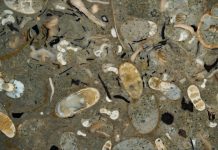
In a remarkable discovery on a Somerset beach, UK, the Reynolds family uncovered fossilized remains that have led scientists to identify a new species of gigantic ichthyosaur, a prehistoric marine reptile.
This oceanic giant, now named Ichthyotitan severnensis, or “giant fish lizard of the Severn,” is estimated to have been over 25 meters long, rivaling the size of today’s blue whales.
The adventure began in May 2020 when Justin Reynolds and his daughter Ruby, from Braunton, Devon, found the first pieces of a massive jawbone while fossil hunting at Blue Anchor, Somerset.
Recognizing the significance of their find, they contacted Dr. Dean Lomax, a renowned ichthyosaur expert at The University of Manchester.
Dr. Lomax had previously studied a similar giant jawbone discovered in 2016 by Paul de la Salle, another fossil enthusiast, at a nearby location.
The newly found jawbone turned out to be more complete and better preserved than the previous one. “I was amazed by the find,” Dr. Lomax said.
He and his team, including Paul de la Salle, determined that the new specimen shared unique features with the earlier discovery, confirming the presence of a previously unknown giant ichthyosaur species from the same geological period.
Excited by their initial discovery, Justin, Ruby, and Paul, accompanied by Dr. Lomax and several family members, returned to the site to search for more pieces.
Their efforts paid off as they gradually unearthed additional fragments of the jawbone, which fit together perfectly like a multimillion-year-old jigsaw puzzle.
The complete jawbone was assembled after recovering the last piece in October 2022. Dr. Lomax and his research team concluded that the bones belonged to a new species of ichthyosaur about 202 million years old, dating back to the Rhaetian stage of the Late Triassic Period. This was a time when giant ichthyosaurs swam the seas while dinosaurs roamed the land, just before a mass extinction event that marked the end of many large marine reptiles.
The discovery of Ichthyotitan severnensis provides a rare glimpse into the life of these massive creatures, which were among the largest vertebrates to have ever existed. The research, published in the journal PLOS ONE, also suggests that these ichthyosaurs were still growing at the time of death, indicating their potential to reach even greater sizes.
Dr. Lomax praised Ruby and Justin’s keen eye in recognizing the significance of their find and invited them to join the research team. Ruby, thrilled by the experience, said, “It was so cool to discover part of this gigantic ichthyosaur. I am very proud to have played a part in a scientific discovery like this.”
Further studies by Marcello Perillo, a master’s student from the University of Bonn, Germany, confirmed the ichthyosaur origin of the bones and revealed details about their growth patterns, shedding light on the unique bone development strategies of these ancient giants.
Paul de la Salle expressed joy over the impact of his original discovery, which has now been complemented by the Reynolds’ find, saying, “To think that my discovery in 2016 would spark so much interest in these enormous creatures fills me with joy.”
The discoveries by Ruby, Justin, and Paul will soon be featured in an exhibit at the Bristol Museum and Art Gallery, providing the public a chance to marvel at these relics from a bygone era.
Dr. Lomax remains hopeful that further excavations might one day reveal a complete skeleton, offering even deeper insights into the lives of these fascinating marine giants.
Source: University of Manchester.



